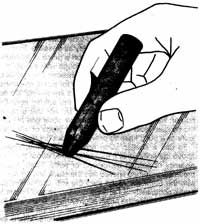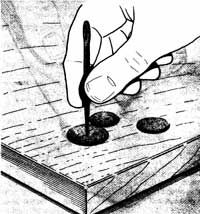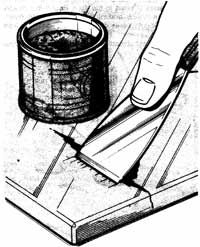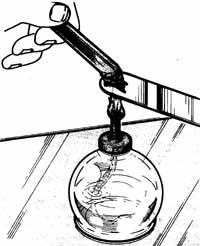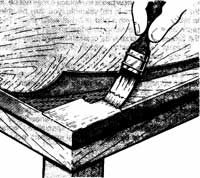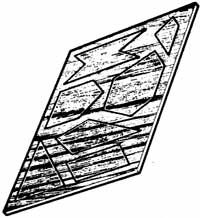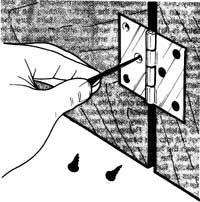
From scratches to discoloration, the surfaces of your wooden furniture are vulnerable to all kinds of damage. Luckily, many of the problems can be fixed.
In this article, we'll tell you how. You'll learn how to repair everything from gouges to burns. You'll even find tips for repairing furniture veneer and hardware. We'll start by discussing surface stains and discoloration.
Advertisement
Removing Stains and Discoloration
Most finishes protect the surface of wooden furniture by forming a protective coating. To repair a damaged finish coating, work only to the depth that it's affected. On any surface, work carefully, and don't remove more of the finish than you have to. In this article, we'll discuss this and other simple techniques to help you remove stains, blushing, and other discoloration from the surfaces of wooden furniture.
White spots: Shellac and lacquer finishes are not resistant to water and alcohol. Spills and condensation from glasses can leave permanent white spots or rings on these finishes. To remove these white spots, first try polishing the surface with liquid furniture polish; buff the surface firmly. If this doesn't work, lightly wipe the stained surface with denatured alcohol. Use as little alcohol as possible; too much will damage the finish.
If neither polishing nor alcohol treatment removes the white spots, the damaged finish must be treated with abrasives. Gentle abrasives can be purchased from a home-supply store. To make your own gentle abrasive, mix cigarette ashes to a paste with a few drops of vegetable oil, light mineral oil, or linseed oil. Rub the ash-oil paste over the stained area, along the grain of the wood, and then wipe the surface clean with a soft cloth. If necessary, repeat the procedure. Stubborn spots may require several applications. Then wax and polish the entire surface.
If rubbing with ashes is not effective, go over the stained area with a mixture of rottenstone and linseed oil. Mix the rottenstone and oil to a thin paste, and rub the paste gently over the stain, along the grain of the wood. Rottenstone is a fast-cutting abrasive, so rub very carefully. Check the surface frequently to make sure you aren't cutting too deep. As soon as the white spots disappear, stop rubbing and wipe the wood clean with a soft cloth. Then apply two coats of hard furniture wax and buff the wood to a shine.
Blushing: Blushing, a white haze over a large surface or an entire piece of furniture, is a common problem with old shellac and lacquer finishes. The discoloration is caused by moisture, and it can sometimes be removed the same way white spots are removed. Buff the surface lightly and evenly with No. 0000 steel wool dipped in linseed oil. Work with the grain of the wood, rubbing evenly on the entire surface, until the white haze disappears. Then wipe the wood clean with a soft cloth, apply two coats of hard furniture wax, and buff the surface to a shine.
Blushing can sometimes be removed by reamalgamation. If the surface is crazed or alligatored, reamalgamation should be used instead of steel-wool rubbing. If neither rubbing nor reamalgamation removes the haze, the piece of furniture must be refinished.
Black spots: Black spots are caused by water that has penetrated the finish completely and entered the wood. They cannot be removed without damage to the finish. If the spots are on a clearly defined surface, you may be able to remove the finish from this surface only; otherwise, the entire piece of furniture will have to be stripped. When the finish has been removed, bleach the entire stained surface with a solution of oxalic acid. Then refinish as necessary.
Ink stains: Ink stains that have penetrated the finish, like black water spots, cannot be removed without re-finishing. Less serious ink stains can sometimes be removed. Lightly buff the stained area with a cloth moistened with mineral spirits; then rinse the wood with clean water on a soft cloth. Dry the surface thoroughly, and then wax and polish it.
If this does not remove the ink, lightly rub the stained area, along the grain of the wood, with No. 0000 steel wool moistened with mineral spirits. Then wipe the surface clean and wax and polish it. This treatment may damage the finish. If necessary, refinish the damaged spot as discussed below. If the area is badly damaged, the entire surface or piece of furniture will have to be refinished.
Grease, tar, paint, crayon, and lipstick spots: These spots usually affect only the surface of the finish. To remove wet paint, use the appropriate solvent on a soft cloth -- mineral spirits for oil-base paint, water for latex paint. To remove dry paint or other materials, very carefully lift the surface residue with the edge of a putty knife. Do not scrape the wood, or you'll scratch the finish. When the surface material has been removed, buff the area very lightly along the grain of the wood with No. 0000 steel wool moistened with mineral spirits. Then wax and polish the entire surface.
Wax and gum spots: Wax and gum usually come off easily, but they must be removed carefully to prevent damage to the finish. To make the wax or gum brittle, press it with a packet of ice wrapped in a towel or paper towel. Let the deposit harden; then lift it off with your thumbnail. The hardened wax or gum should pop off the surface with very little pressure. If necessary, repeat the ice application. Do not scrape the deposit off, or you'll scratch the finish.
When the wax or gum is completely removed, buff the area very lightly along the grain of the wood with No. 0000 steel wool moistened with mineral spirits. Then wax and polish the entire surface.
Spot Refinishing
Any repair that involves removing the damaged finish completely -- deep scratches, gouges, burns, or any other damage -- also involves refinishing the repair area. Spot refinishing is not always easy, and it's not always successful, especially on stained surfaces. If the damage isn't too bad, it's worth trying. If you'll have to touch up several areas on one surface, you're probably better off refinishing the surface or the piece of furniture completely.
To stain one area on a surface, use an oil-based stain that matches the surrounding stain. You may have to mix stains to get a good match. Test the stain on an inconspicuous unfinished part of the wood before working on the finished surface.
Before applying the stain, prepare the damaged area for finishing. Sealing is not necessary. Apply the stain to the damaged area with an artists' brush or a clean cloth, covering the entire bare area. Let the stain set for 15 minutes and then wipe it off with a clean cloth. If the color is too light, apply another coat of stain, wait 15 minutes, and wipe again. Repeat this procedure until you're satisfied with the color; then let the stain dry according to the manufacturer's instructions.
Lightly buff the stained surface with No. 0000 steel wool, and wipe it clean with a tack cloth. Apply a new coat of the same finish already on the surface -- varnish, penetrating resin, shellac, or lacquer -- over the newly stained area, feathering out the new finish into the surrounding old finish. Let the new finish dry for one to two days, and lightly buff the patched area with No. 0000 steel wool. Wax the entire surface with hard paste wax, and polish it to a shine.
Read the next page to find what to do if your furniture has scratches, dings, or dents.
Advertisement
